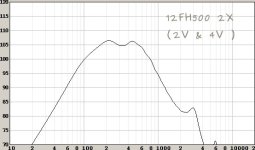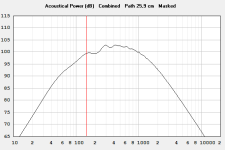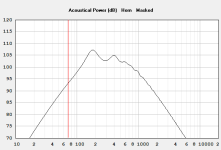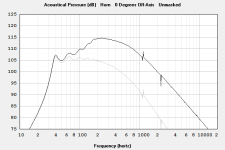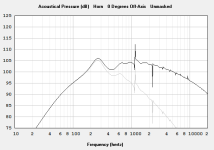hi,
i just got my hands on four faitalPRO 12fh500 used for 350 euros.
my idea was to build four 15" tapped horns (JBELL SS15) and use my 12fh500 as midrange drivers.
i was wondering, is there any clever design i can do to increase the sensitivity of these? i am running an off grid setup on generators and want it efficient.
my SS15 will have a response curve like this:

some guy sent me this curve a couple of years ago that i saved:

i think he used four 8" car speakers in back of his car. the box looked something like this: https://en.toutlehautparleur.com/midrange-kit-tlhp-tt-112-with-cabinet-kit-and-speaker.html
i feel like that response curve would be perfect for my SS15 setup. is it something similar i can do with my 12fh500 drivers? 1000hz should be high enough to let compression drivers take over the job, right?
i just got my hands on four faitalPRO 12fh500 used for 350 euros.
my idea was to build four 15" tapped horns (JBELL SS15) and use my 12fh500 as midrange drivers.
i was wondering, is there any clever design i can do to increase the sensitivity of these? i am running an off grid setup on generators and want it efficient.
my SS15 will have a response curve like this:
some guy sent me this curve a couple of years ago that i saved:
i think he used four 8" car speakers in back of his car. the box looked something like this: https://en.toutlehautparleur.com/midrange-kit-tlhp-tt-112-with-cabinet-kit-and-speaker.html
i feel like that response curve would be perfect for my SS15 setup. is it something similar i can do with my 12fh500 drivers? 1000hz should be high enough to let compression drivers take over the job, right?
Last edited:
Greets!
IME we get the most efficiency in theory by reactance annulling it and my non technical (higher math) way is to take the mean of the desired loading BW and tune the compression (rear) chamber to it with hyperbolic flare factor the most efficient, though best to use expo for mids/HF to keep throat distortion 'reasonable', i.e. not actually reactance annulled.
Anyway, looking forward to seeing your optimized results using HR/other horn design programs.
IME we get the most efficiency in theory by reactance annulling it and my non technical (higher math) way is to take the mean of the desired loading BW and tune the compression (rear) chamber to it with hyperbolic flare factor the most efficient, though best to use expo for mids/HF to keep throat distortion 'reasonable', i.e. not actually reactance annulled.
Anyway, looking forward to seeing your optimized results using HR/other horn design programs.
GM,
wow. i am not sure if i understood a single word in your post 😀
freddi,
ah, i found the horn https://inlowsound.weebly.com/diy-100hz-midbass-horn.html
these are the drivers i will be using: https://audio55.se/sv/products/tw-75
that response curve would totally work for my use case. although.... 40 inches... a bit more than i was hoping for 😀
can i take his design right off? or do i have to modify it?
wow. i am not sure if i understood a single word in your post 😀
freddi,
ah, i found the horn https://inlowsound.weebly.com/diy-100hz-midbass-horn.html
these are the drivers i will be using: https://audio55.se/sv/products/tw-75
that response curve would totally work for my use case. although.... 40 inches... a bit more than i was hoping for 😀
can i take his design right off? or do i have to modify it?
Last edited:
GS Audio TW-75:
Fs = 460 HzQts = 0.73
Upper mass corner (Fhm = 2*460/0.73 = ~1260 Hz)
Fc = (460*1260)^0.5 = ~761 Hz
If wanting to load down to Fs, then need to design based on 0.6 - 0.7x Fs and ideally need to factor in any series resistance from wiring, thermal power distortion, etc., i.e. use Qts' to design with:
https://web.archive.org/web/20220707003028/http://www.mh-audio.nl/Calculators/newqts.html
Last edited:
i have been trying out this hornresp thingie
and i have no real clue what i'm doing. i just fill in different values and see what happens loll. but i suppose i am looking for a bessel horn? those are the square ones right?



so far this is what i got 😀 it's about the same size as that 135 hz horn... i somehow lost the possibility to change S2 S3 parameters. i dont know why that happened.... although this response is worse than just using the horn parameters that already was filled in from the beginning
and i have no real clue what i'm doing. i just fill in different values and see what happens loll. but i suppose i am looking for a bessel horn? those are the square ones right?
so far this is what i got 😀 it's about the same size as that 135 hz horn... i somehow lost the possibility to change S2 S3 parameters. i dont know why that happened.... although this response is worse than just using the horn parameters that already was filled in from the beginning
Attachments
Last edited:
this horn is only 45cm, long and 1500cm2 in the opening. is this good? i am not experienced enough to say.. good extension to 1000hz so integration with tweeter will not be a problem at all? not so good under 170hz though? will something like this work with my tapped horns and compression drivers?
maybe this would be better:
60cm length, 1500cm2 opening, a bit better lower end
Attachments
Last edited:
Use the math I posted with the 12TH500. Also, if wanting help with HR, please Export, attach the file's .txt for us to DL/view/modify
What about B&C 12PE32 or 12MH32? They both have Qts under .20, 100dB+ sensitivity and Fs of about 52hz. The 12PE32 will go pretty far up being a 12 with a very high EBP of 265 and the 12MH32 will go a bit lower with more Xmax and an ever so slightly better EBP of 268
Thanks! Nothing, it just determines how high a driver can be box loaded, so above this point its a flat line in a sim unless inductance (Le) is listed, which shows how 'fast' its HF rolls off.here it is
i am not really sure what to do with the qts
Alright i see. Please check if the design i made is reasonable and if i got the the parameters correct
Just to avoid confusion: Horns that cover ~100Hz - 1kHz or so are usually referred to as midbass horns. When we talk about midrange horns, we usually mean smaller horns loaded with compression drivers.
I took a quick look at the datasheets for your Faital pro drivers and as far as I can tell they should be fairly suitable for the job.
I took a quick look at the datasheets for your Faital pro drivers and as far as I can tell they should be fairly suitable for the job.
Unless I have misunderstood something, what I see regards a narrow-band very high efficiency application
that doesn't even resemble a 'flat' frequency response 😕
( after EQ, what becomes of efficiency ? )
that doesn't even resemble a 'flat' frequency response 😕
( after EQ, what becomes of efficiency ? )
What Low Frequency driver arrangement would be suitable to match such high efficiency ?
I guess that such a system would have to be Bi or Tri amped.
( not exactly ideal for an "off the grid" scenario )
I guess that such a system would have to be Bi or Tri amped.
( not exactly ideal for an "off the grid" scenario )
FaitalPro 12TH500:
Fs = 45 Hz
Qts = 0.25
Upper mass corner (Fhm = 2*45/0.25 = 360 Hz)
Fc = (45*360)^0.5 = ~127 Hz
From this it's obvious it's not normally considered suitable for a midrange horn (250 - 2 kHz) primarily due to poor polar response. Attached is a full size expo horn on axis in half space (shaded design) required to yield max efficiency and a 250 - 2 kHz mid horn on axis and in half space.
Mid horn:
Fc = (250*2000)^0.5 = ~707 Hz
As you can see, when horn loading a driver not suited for the desired passband you wind up with < optimal results, though fiddle with it to see if you can find an acceptable compromise.
Fs = 45 Hz
Qts = 0.25
Upper mass corner (Fhm = 2*45/0.25 = 360 Hz)
Fc = (45*360)^0.5 = ~127 Hz
From this it's obvious it's not normally considered suitable for a midrange horn (250 - 2 kHz) primarily due to poor polar response. Attached is a full size expo horn on axis in half space (shaded design) required to yield max efficiency and a 250 - 2 kHz mid horn on axis and in half space.
Mid horn:
Fc = (250*2000)^0.5 = ~707 Hz
As you can see, when horn loading a driver not suited for the desired passband you wind up with < optimal results, though fiddle with it to see if you can find an acceptable compromise.
Attachments
A rhetorical Q I presume.( after EQ, what becomes of efficiency ? )
 😉
😉Normally an array, bass horn or the DIY THs he listed in his opening post. 😉What Low Frequency driver arrangement would be suitable to match such high efficiency ?
I guess that such a system would have to be Bi or Tri amped.
( not exactly ideal for an "off the grid" scenario )
Not necessarily, but for his prosound app, a good plan.
- Home
- Loudspeakers
- Multi-Way
- midrange horn design?
